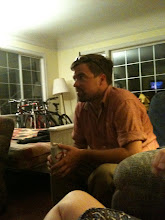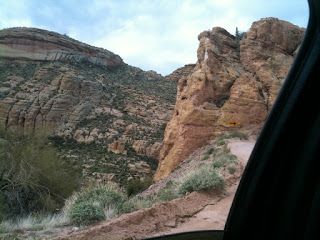
I had picked up a load of imported Target merchandise from NYK Logistics in the LBC. For those of you not as "West Coast" as my self that's Long Beach, California, I will try and avoid thuggin out too hard henceforth.) This load of trinkets from Japan and China was headed to a Distribution Center in Pueblo, Colorado 1200 miles distant. Often there are multiple routes available to get from one point to another and many truckers just pick the Interstate, that uniform 4+ lane strip of dullness where the mountains are cut through and the valleys filled making travel through them easier, faster, and more unremarkable. Anyone who has driven across the country (or even any state) and found it dull did so on the interstate (or is just a hater, in which case, quit wasting gas.)
The back roads are often shorter, slower and almost invariably more interesting. Besides the towns and villages where you might encounter people smaller roads traverse terrain where building larger roads would be impossible or not cost efficient. i.e. prettier country. My advice, if you have the time, take the back roads.
HOWEVER, there are stretches of interstate with mind bending scenery. You can't avoid beauty that assiduously. Some such stretches are I-90 from Ellensburg to Seattle, Washington over Snoqualmie Pass in the Cascades (the only stretch of Interstate that is designated a national scenic byway), I-5 over the grapevine in Southern California, I-81 along the Blue Ridge in Virginia etc... Most of these roads clearly connect two important areas that need connecting an in so doing must surmount apparent obstacles (typically abrupt changes in elevation, mountains.) Some areas, however make you wonder why they would have ever put a interstate here, two such locations are ones that I had to travel to move this target shit to Colorado. I-15 through the Virgin River Gorge in the far northwestern Arizona and I-70 through the San Raphael Swell in central Utah.
The push to carve a highway in the Virgin River Gorge is more understandable as it connects Las Vegas and Los Angeles to the valley of the Great Salt Lake. There is an enormous elevation obstacle along this route in the name of the Colorado Plateau. I'm not going to get too geologically specific but suffice it to say this region, centered around the 4 corners area, was uplifted in millenia past by whatever it is that uplifts the earth. With all this elevation, and water still wanting, as it does, to flow down hill, gradually canyons were cut through this elevation creating the scenic amazements that are the Grand Canyon and the parks of Utah: Canyonlands, Bryce Canyon, Capital Reef and Zion. The Virgin River, which flows southwest out of Zion eventually tumbles off the plateau and into the Mojave Desert in so doing carving itself a nice canyon in the far northwest corner of Arizona (just to give you an idea of the elevation differential here, Vegas, down in the low hot Mojave, is at 2000 ft and Cedar City, UT is at over 5,800.
Naturally when looking for a way to mount this rise the interstate builders looked for a precut route and the Virgin River Gorge was just such a route. Nonetheless, mile for mile, it was one of the most expensive stretches of interstate. Some pictures:

Entering the Gorge

Curvyness

Up on the Plateau in Utah
In the next episode: The insanity that is The San Raphael Swell...





















